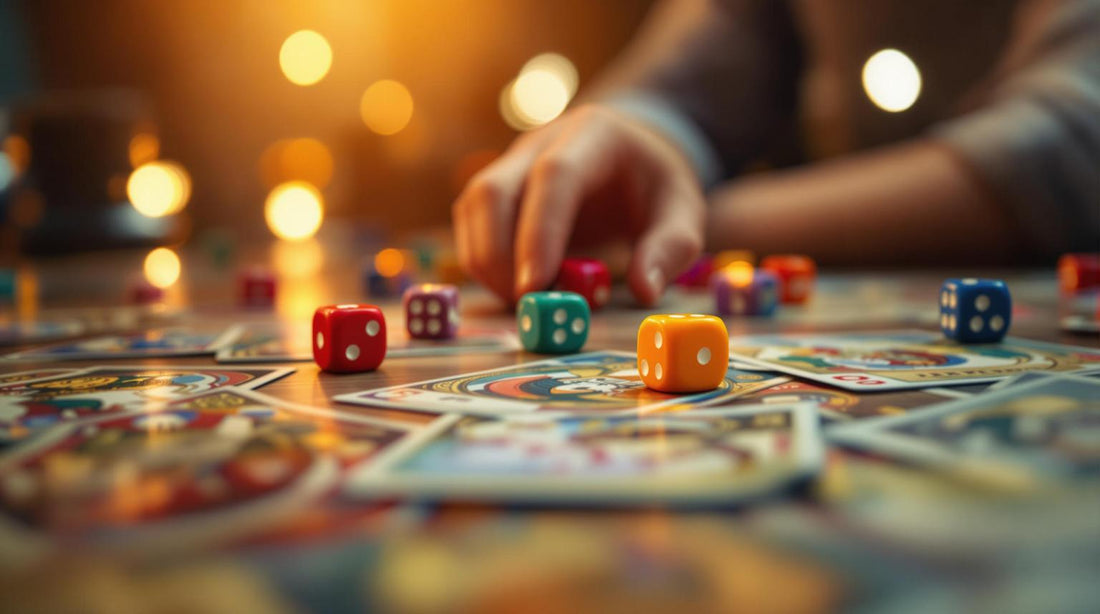Discover the Best Board Games for Every Player

Card Play vs. Dice Rolls: Conflict Resolution Compared
Cards and dice are the backbone of conflict resolution in board games, each offering unique gameplay experiences. Cards emphasize strategy and planning, while dice focus on quick decisions and unpredictability. Choosing the right system depends on whether you value control or excitement in your games.
Key Differences:
- Cards: Controlled randomness, strategic planning, and resource management.
- Dice: Instant outcomes, high tension, and fast-paced gameplay.
Quick Comparison:
| Aspect | Card-Based Systems | Dice-Based Systems |
|---|---|---|
| Randomness Type | Controlled, changes over time | Fixed probabilities |
| Player Agency | High – manage hands/decks | Moderate – rerolls/modifiers |
| Game Flow | Slower due to planning | Fast-paced |
| Strategy Depth | Rewards long-term planning | Tactical, moment-to-moment |
For a hybrid experience, some games combine cards and dice to balance strategy with chance. Whether you prefer thoughtful planning or thrilling randomness, there's a system that fits your style.
Related video from YouTube
Card-Based Systems: Planning and Skill
Card-based conflict resolution systems put a spotlight on thoughtful planning and decision-making. These systems reward players who approach gameplay with strategy and foresight.
Benefits of Using Cards
Using cards introduces a level of predictability and control that dice rolls can't match. Players can analyze their hand, plan their moves, and make decisions based on the resources they hold. Features like deck management and crafting specific card combinations add layers of complexity, giving players more influence over the game's outcome.
| Advantage | Description | Impact on Gameplay |
|---|---|---|
| Information Control | Players can plan based on their cards | Reduces randomness |
| Deck Building | Customizable card combinations | Encourages strategic setups |
| Skill Development | Understanding card interactions | Rewards practice and experience |
But, as with any system, there are trade-offs.
Limits of Card Systems
While card mechanics provide strategic opportunities, they aren't without challenges. Frequent shuffling is required to keep the game fair and random, which can disrupt the flow of play. Additionally, experienced players may identify optimal strategies, making the gameplay stale or predictable over time. These limitations are worth considering when evaluating the effectiveness of card-based systems.
Top Card-Based Games
Some games highlight the versatility of card-based mechanics:
- Pikoko blends card play with strategic betting, forcing players to adapt their tactics as the game progresses.
- Karakum shows that even simple mechanics can deliver depth, balancing complexity with ease of play.
Both titles, available through retailers like Brain Games, showcase how card-based systems can create engaging and varied experiences. Beyond entertainment, these systems also have educational applications. For instance, The Talking, Feeling & Doing Conflict Resolution Card Game has earned a high rating of 4.79 out of 5 from 150 reviews, demonstrating its value in teaching conflict resolution skills.
Dice-Based Systems: Chance and Speed
Dice mechanics bring an element of unpredictability that keeps conflict resolution fast-paced and engaging. While card systems emphasize planning and strategy, dice focus on chance and sudden shifts, offering a completely different dynamic.
Benefits of Using Dice
Dice systems stand out for their simplicity and immediacy. Unlike cards, dice deliver instant outcomes, keeping the game moving and players on their toes. Here's why they work so well in gameplay design:
| Benefit | Description | Impact |
|---|---|---|
| Speed | Instant results | Keeps the game flowing |
| Drama | Unpredictable outcomes | Builds tension and suspense |
| Probability Control | Adjustable difficulty scales | Fine-tunes challenge levels |
| Accessibility | Simple, easy-to-learn rules | Lowers the barrier to entry |
Dice systems also allow for precise probability structures, with different combinations of dice creating varied probability distributions.
Limits of Dice Systems
The randomness that makes dice exciting can also create challenges. While they inject drama, dice can sometimes let luck overshadow skill, which may frustrate players who feel their strategic decisions aren't rewarded.
"It is a simple process to tie the random result to a narrative meaning, and that's what makes dice work so well at provoking feelings in our TTRPG games." - Brandon Gutowski, C22 System
For game designers, the challenge lies in balancing the thrill of randomness with the need for meaningful player decisions.
Top Dice-Based Games
Despite these limitations, many games show how dice mechanics can be used in clever ways to enhance gameplay. Modern board games have moved far beyond basic roll-and-move systems, offering innovative takes on dice usage:
- The Castles of Burgundy: Dice rolls are used as action selection tools. Players can modify results through worker placement mechanics, adding a strategic layer to the randomness.
- Troyes: Dice become resources that players can trade with one another. This introduces economic and social dimensions to the traditional dice mechanic.
- Dice Forge: Players can physically modify their dice during the game, creating a sense of progression and reducing the reliance on pure chance.
These examples highlight how thoughtful design can address the challenges of dice systems while keeping their energy and simplicity intact. By blending randomness with player agency, these games demonstrate how dice mechanics can support complex and rewarding gameplay.
sbb-itb-1ed942f
Direct Comparison: Cards vs. Dice
System Comparison Chart
To choose the right mechanics for your game, it's helpful to understand the differences between card- and dice-based systems. Here's a breakdown of how they compare:
| Aspect | Card-Based Systems | Dice-Based Systems |
|---|---|---|
| Randomness Type | Controlled randomness that changes as cards are used | Fixed probabilities with each roll |
| Outcome Predictability | Becomes clearer as the deck is depleted | Stays consistent every time |
| Player Agency | Higher – players can manage hands and build decks | Moderate – influenced by rerolls and modifiers |
| Resource Management | Focused on conserving cards and planning | Limited to managing the dice pool |
| Learning Curve | More complex – players need to understand card interactions | Easier – relies on familiar probability |
| Game Flow | Can slow down due to shuffling and hand management | Quick and straightforward |
| Strategy Depth | Rewards long-term planning | Encourages tactical responses to rolls |
These differences play a big role in shaping how the game feels and flows.
Effects on Gameplay
Cards and dice impact gameplay in very different ways. Card-based systems are ideal for games that reward strategic planning and resource management. As Scott Caputo explains, "If you have a killer card in your deck, you know it's guaranteed to appear in your hand eventually. That's a big difference with a die. If your killer move is on a die face, that die face may never be rolled."
Dice-based systems, on the other hand, are perfect for fast-paced resolutions and creating dramatic moments. Their fixed probability keeps tension steady, making them great for combat-heavy games or situations where quick decisions are key.
Card systems use a "picking-without-replacement" mechanic - once a card is played, it’s out of the mix until reshuffling. This shifts probabilities as the game progresses, requiring players to carefully plan and manage their resources. Dice, however, can lead to streaks of bad rolls, which may frustrate players. But unlike cards, dice keep the action moving quickly.
"The use of cards as resource/randomizers and as narrative prompts were pretty well developed and understood by the end of the '10s...cards can offer a lot more depth than dice: what a difference a randomization medium makes!" - appelcline
Many modern games mix cards and dice, combining the strategic planning of cards with the fast, unpredictable excitement of dice. This hybrid approach helps balance their strengths while minimizing their weaknesses.
Mixed Systems and New Methods
Mixed systems combine cards and dice to create new ways of handling conflict resolution in games. These approaches bring together strategy and unpredictability, offering players a dynamic experience.
Games with Mixed Systems
Blending cards and dice allows designers to combine strategic decision-making with the excitement of chance. For example, in 16 Chickens Dice Fight to the Death, players draft cards strategically while relying on dice rolls for combat outcomes. Similarly, Dice Fight: Ready to Roll? uses fight cards to tweak dice values, adding another layer of strategy to the gameplay.
In these systems, cards often handle planning and resource management, while dice resolve actions and introduce randomness. This combination creates gameplay that's both thoughtful and unpredictable, paving the way for creative conflict resolution techniques.
New Conflict Resolution Methods
Recent advancements have explored how specialized card decks and dice can work together to change probability outcomes. Unlike dice, cards offer unique mechanics - particularly when discarded permanently - that allow for deeper strategic possibilities. By the late 2010s, designers were using cards as both resource generators and narrative tools, showcasing their ability to provide more complexity compared to dice.
Here are some standout methods that have emerged:
- Tarot Integration: Major arcana cards trigger special events, while numbered cards handle general resolutions. This approach adds thematic richness without sacrificing clarity.
- Initiative Cards: Cards determine turn order, while dice resolve actions. This method simplifies tracking turns and minimizes ties.
- Probability Shifting: Cards can alter dice results, giving players strategic options that combine planning with chance.
- Resource Management: Cards act as resources that influence dice outcomes, adding layers of strategy to random elements.
The challenge for designers is to keep gameplay engaging without making mechanics overly complex.
Conclusion: Picking the Best System
Key Takeaways
When deciding between card-based and dice-based conflict resolution systems, it’s all about the type of gameplay you want to create. Card systems offer more control and strategy, while dice systems thrive on unpredictability and fast-paced action. These core differences are essential for shaping the player experience and should guide your choice.
Suggestions for Designers and Players
Choose a system that aligns with your game’s goals. For games that emphasize strategy, cards are a great fit. For something more dynamic and unpredictable, dice are the way to go. If you’re working with dice but want to reduce randomness, try:
- Adding reroll mechanics
- Including ways to adjust dice outcomes
- Allowing dice to serve multiple purposes
For card-based games, you can enhance gameplay by:
- Tweaking hand sizes
- Offering multiple card sources
- Designing cards with flexible uses
These practical tips can help you fine-tune your game mechanics to create the experience you’re aiming for.
Explore Games at Brain Games

Ready to find games that match your style? Brain Games offers a variety of options, from strategic card games to action-packed dice games. Each game comes with detailed descriptions of the mechanics, and there's even an exchange guarantee to ensure you find the perfect fit for your preferences.






